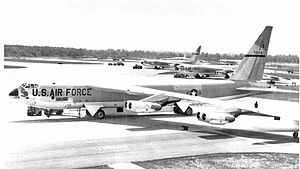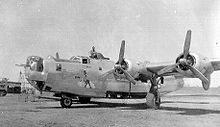
The 456th Bombardment Wing is an inactive United States Air Force unit. It was last assigned to the 14th Air Division of Strategic Air Command at Beale Air Force Base, California, where it was inactivated on 30 September 1975. The wing's predecessor was the 456th Bombardment Group, a World War II United States Army Air Forces combat organization that flew from Italy while assigned to Fifteenth Air Force. It earned two Distinguished Unit Citations for valor in combat and participated in the strategic bombing campaign against oil production targets including those near Ploiești, Romania, attacks that resulted in high bomber losses. The group also served as a troop carrier unit in the Air Force Reserve from 1947 to 1949 and as the flying element of the wing from 1952 to 1955.

The 454th Bombardment Wing is an inactive United States Air Force unit. It was last assigned to the 42d Air Division of Strategic Air Command (SAC) at Columbus Air Force Base, Mississippi. It was inactivated on 25 July 1969.
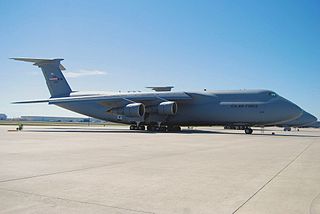
The 356th Airlift Squadron is a United States Air Force Reserve squadron, assigned to the 433d Operations Group Air Force Reserve Command, stationed at Kelly Field Annex, Joint Base San Antonio, Texas. The 356th is a C-5M Super Galaxy Formal Training Unit.

The 454th Bombardment Group is an inactive United States Air Force unit. It was last assigned to the 454th Troop Carrier Wing of Continental Air Command at Portland International Airport, Oregon. It was inactivated on 1 January 1953.

The 482d Operations Group is a United States Air Force Reserve unit assigned to the 482d Fighter Wing. It is stationed at Homestead Air Reserve Base, Florida.

The 448th Supply Chain Management Group is an inactive United States Air Force unit. Its last assignment was to the 448th Supply Chain Management Wing at Tinker Air Force Base, Texas, where it was inactivated on 30 June 2010.
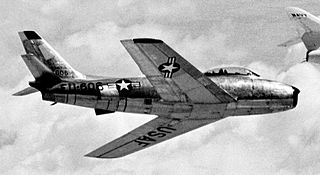
The 812th Fighter-Bomber Squadron is an inactive United States Air Force unit. Its last assignment was with 482d Fighter-Bomber Group stationed at Dobbins Air Force Base, Georgia.

The 813th Fighter-Bomber Squadron is an inactive United States Air Force unit. Its last assignment was with 482d Fighter-Bomber Group at Dobbins Air Force Base, Georgia.
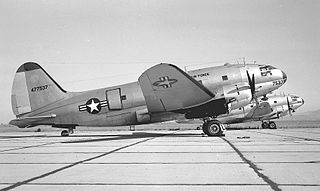
The 814th Troop Carrier Squadron is an inactive United States Air Force unit. Its last assignment was with 482d Troop Carrier Group stationed at Miami International Airport, Florida.

The 781st Bombardment Squadron is an inactive United States Air Force unit. Its last assignment was to the 465th Bombardment Wing, stationed at Robins Air Force Base, Georgia. It was inactivated on 25 July 1968.

The 775th Troop Carrier Squadron is an inactive United States Air Force unit. It was last assigned to the 1st Air Commando Wing at Hurlburt Field, Florida in July 1964.

The 348th Reconnaissance Squadron is an active United States Air Force squadron, assigned to the 319th Operations Group. It was activated at Grand Forks Air Force Base, North Dakota on 19 September 2011. It currently operates the RQ-4 Global Hawk, High Altitude Intelligence, Surveillance, and Reconnaissance Remotely Piloted Aircraft.

The 744th Bombardment Squadron is an inactive United States Air Force unit. It was last assigned to the 456th Bombardment Wing at Beale Air Force Base, California, and was inactivated on 30 September 1975, when its assets were transferred to another unit.

The squadron was the 739th Bombardment Squadron, which was activated in June 1943. After training in the United States with the Consolidated B-24 Liberator, the 739th deployed to the Mediterranean Theater of Operations, participating in the strategic bombing campaign against Germany. It earned two Distinguished Unit Citations for its combat operations. Following V-E Day, the squadron returned to the United States for conversion as a very heavy bomber unit, but was inactivated instead.

The 738th Expeditionary Airlift Squadron is a provisional United States Air Force unit. It is assigned to Air Combat Command (ACC) to activate or inactivate as needed. It operates Lockheed C-130 Hercules aircraft in theater airlift missions as part of the Global War on Terrorism. Its current status and duty location is undetermined.

The 737th Expeditionary Airlift Squadron is a provisional United States Air Force unit assigned to Air Combat Command (ACC) to activate or inactivate as needed. It operates Lockheed C-130 Hercules aircraft in theater airlift missions as part of the Global War on Terrorism. Its current status and duty location is undetermined.
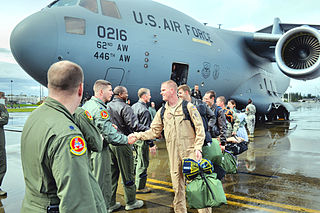
The 817th Expeditionary Airlift Squadron is a provisional United States Air Force unit, assigned to Air Mobility Command to activate or inactivate as needed. It engaged in combat operations in Southwest Asia.

The 483d Airlift Group is an inactive unit last assigned to Pacific Air Forces at Osan AB Korea. It was assigned to Twenty-Second Air Force as a VIP transport unit for Headquarters, Seventh Air Force. It was inactivated on 1 June 1992.

The 816th Expeditionary Airlift Squadron was a provisional United States Air Force unit. It is assigned to the 385th Air Expeditionary Group, stationed at Al Udeid Air Base, Doha, Qatar. It was last engaged in combat operations in Southwest Asia.

The 330th Aircraft Sustainment Group was a group of the United States Air Force stationed at Robins Air Force Base, Georgia. It was last active in June 2010
